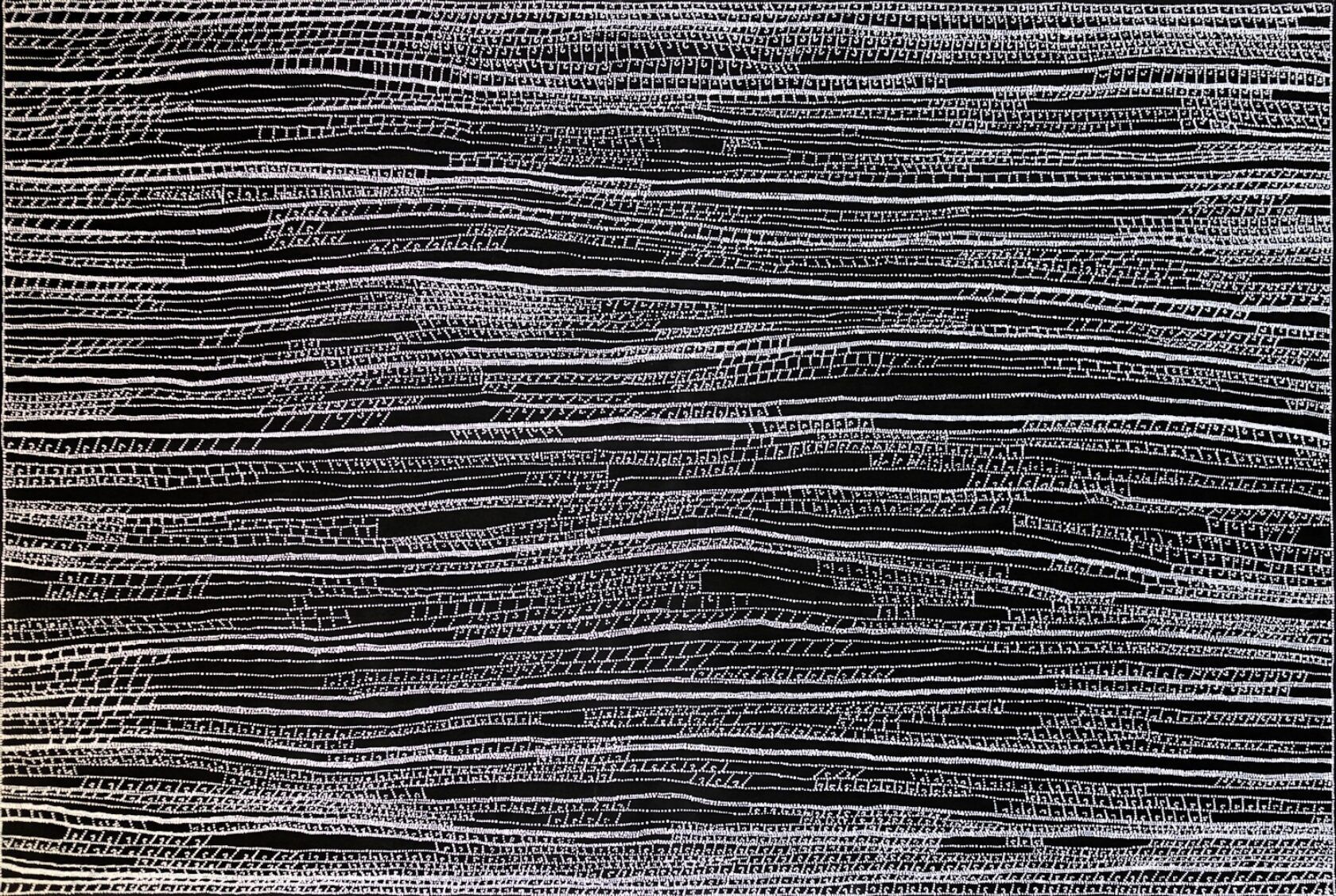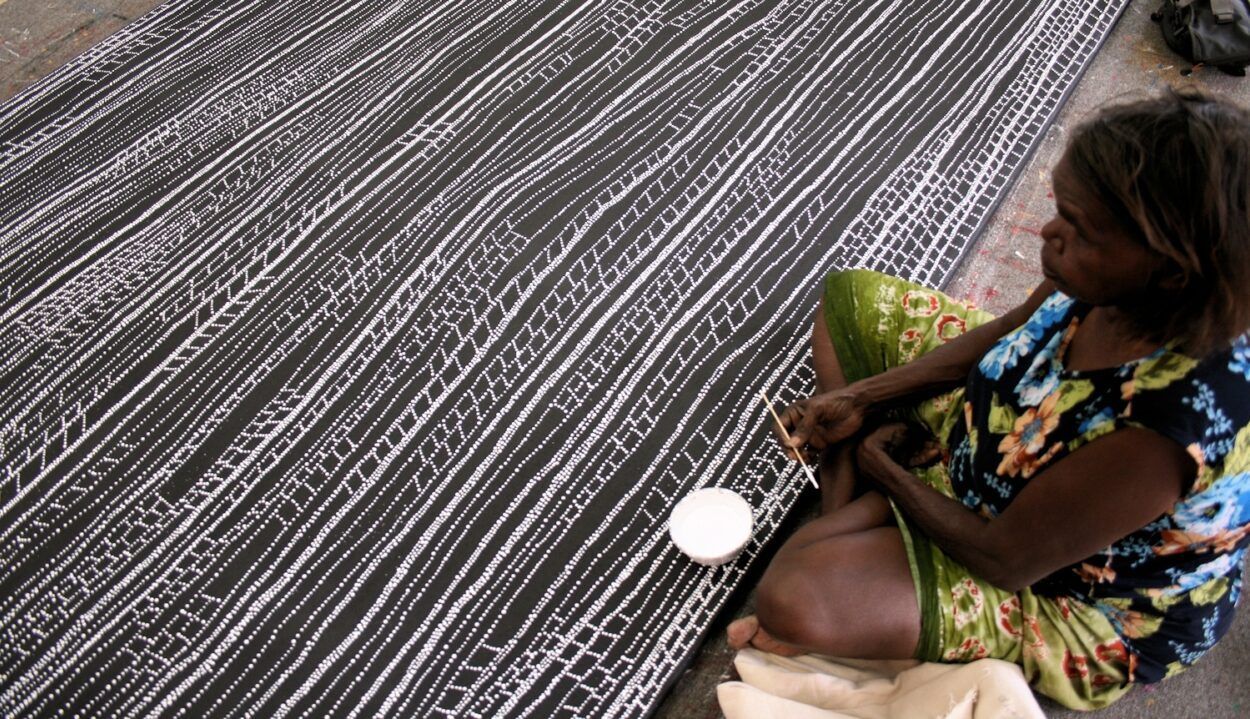Honouring Dorothy Napagardi 2018
14 June - 31 December 2018
"All of our dancing belongs there. When I paint I think of the old days, as a happy little girl knowing my grandfather’s Dreaming."
Gifted artist Dorothy Napangardi was tragically killed in a car accident in 2013 after a day spent doing what she loved most - hunting out bush, surrounded by family and friends.
This exhibition looks back on some of the diverse works by one of Gallery Gondwana’s key artist, Dorothy Napangardi. The works presented are from Gallery Gondwana’s Collection and are being released for sale.
Dorothy was one of the leading artists of the contemporary Aboriginal art movement, and had the honour of being the 2nd indigenous artist to be given a solo survey exhibition at the MCA (Museum of Contemporary Art), Sydney. The exhibition for Napangardi was held from 10 Dec 2002 to 9 Mar 2003 and traced 11 years of her painting career from 1991 to 2002.
Dorothy Napangardi
Salt on Mina Mina 2001
Acrylic on canvas 243 x 167 cm
Winner of the Telstra First Prize - 18th National Aboriginal & Torres Strait Islander Art Award
This painting depicts a major women’s ceremonial site known as Mina Mina, near Lake McKay in the Tanami Desert.
During the Jukurrpa, ancestral women of the Napagardi and Napanangka subsection groups gathered to collect ceremonial digging sticks, kuturu that emerged from the ground. They then proceeded east, performing rituals of song and dance, to the place known as Jankinyi. A large belt of Desert Oak trees (Allocasuarina decaisneana) now stand where these digging sticks once were. The striking design of white dotting depicts the encrustations of salt around the dry claypans of Mina Mina, etched with the tracks of the women.
Source: Gallery Gondwana
In 1998 Dorothy was awarded the Northern Territory Art Award. She was then awarded the Telstra National Aboriginal Art Award twice – for Best Painting in Western Media in 1991 and for the overall category in 2001. Napangardi’s prize winning work in 2001, Salt on Mina Mina has been recognized as a masterpiece. In 2002, Sydney’s Museum of Contemporary Art honored Dorothy Napangardi by giving her a solo exhibition, entitled Dancing Up Country: the art of Dorothy Napangardi.
A highlight in the art calendar for 2018 was the Dorothy Napangardi retrospective exhibition at The Seattle Art Museum (SAM).
Walkabout: The Art of Dorothy Napangardi Walking becomes a rhythm that adjusts to each landscape we cross. Translating that rhythm into paint became a goal for one artist who walked hundreds of miles across her homeland. Dorothy Napangardi was born in the Tanami Desert of Australia, where a crystalline salt-lake region played a powerful role in her life. She spoke of the unconditional happiness and freedom she felt when she traversed her family’s country and slept beside them with stars as a canopy.
A gallery filled with her paintings from 2000–13 takes us to the shimmering salt lake, where she absorbed indigenous laws and stories from the land and her family. Her individual style of intricate dotting can suggest a vast aerial perspective or a microscopic maze.

These beautiful works, are a testament of an artist who reputation continues to grow. The paintings re-defined the art of minimalism. Someone who felt the spirit and captured it in the physical. Tales of the past, told for the future.
From small delicate works that capture the minutiae of the dreaming to the huge canvases that pulled the viewer into its landscape, so it was without any traditional iconography from her familial lines, Dorothy created her own innovative language to portray “her country”.
Her paintings are created by an intricate network of lines that collide and implode on top of each other creating a play of tension and expansion, transporting the viewer through a myriad of intersections. Her view constantly changing: one painting giving an aerial perspective; the next as if she has placed a microscope to the ground.
With a highly experimental and very individual painting style, Dorothy elaborated on the traditional designs of the kurawarri (dreaming). Her paintings focused on her ancestral country, Mina Mina, which is a highly significant sacred site particularly for women, as it is the point of origin for Karntakurlangu Jukurrpa (Women’s Dreaming) for not only the Warlpiri but also for the Kukutja whose traditional lands are to the west.

GALLERY GONDWANA
ABN: 75 009 652 046
All prices displayed in AUD, GST included.
Gallery Gondwana acknowledges the First Peoples of this land and recognises their continuous connection to culture, community and Country.
CONTACT US
+61 417 75 74 75
+61 417 27 44 31
roslyn@gallerygondwana.com.au
PO Box 3770, Alice Springs NT 0871 Australia
Vatu Sanctuary
Saturate yourself and be inspired by the power of Aboriginal art in a living gallery environment.

All Rights Reserved | Gallery Gondwana